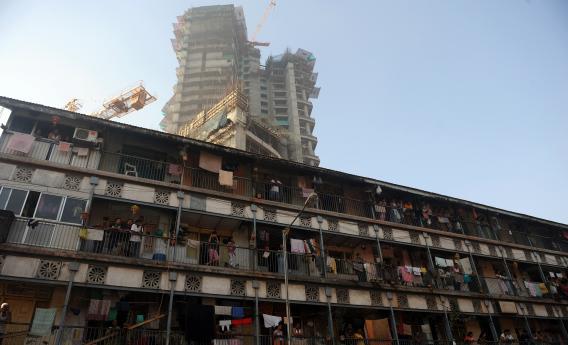Listening to Jeanne Gang's TED talk was challenging. Although I agreed with her views, certain design solutions she proposed sparked skepticism in me, especially the high-rise building in Chicago. The 'balconies for social interaction' idea was too reminiscent of Peter and Allison Smithson's 'streets in the sky' concept, a typology that has been and continues to be demolished in most places it is built. Clearly, outdoor spaces don't work on the fifteenth floor the same way as they do at grade level, and our continued efforts to introduce socialization into high rises have, for the most part, led to no real change in the unsocial, introverted ways in which high-rises function.


What is interesting to me is that while Peter and Allison Smithson's vision for streets in the sky has largely not come to fruition the way they'd hoped, a somewhat similar typology in India has endured many attempts at demolition and obsolecsence. The chawls of Mumbai have 'streets in the sky' in the form of long corridors used both to access individual housing units (single room accommodations, usually) as well as for social purposes. Don't be fooled by the shabby exteriors of the building, an expected issue faced by working class housing. These streets work! In this blog post, I try to analyze some reasons for how the two types of 'streets in the sky' differ and how well they serve their intended purpose.



First, there is a matter of scale. Chawls rarely go over four stories. That seems to be the maximum height at which a human being can situate themselves in without losing connection with their immediate street-level surroundings. Higher buildings provide its occupants with a wider view, but at the cost of an intimate relationship with the immediate neighborhood.
Chawls are often located in neighborhoods full of other chawls. In these neighborhoods, drying clothes in the corridors is not a matter of shame. Neither are many other semi-personal activities that occupants perform without judgment. The regulation of what can and cannot be done in the corridors just for the sake of preserving the looks of a building has long-term negative consequences. It invites fewer people into the corridors and they become reserved for activities like smoking, drinking, and littering. Isn't that worse than a few clothes hanging off of clotheslines?
Peter and Allison Smithson's "streets in the sky" had rigid ideas about what would happen in the streets. They pictured a utopia with kids playing in the streets, bingo nights on the weekends, and so on. I find it hard to imagine kids throwing around a ball at a height of fifty feet or more. It would be so unsafe! I also don't think the streets had the right enclosure for public gatherings. The "streets in the sky" concept attempted to impose functions onto the "streets" in ways that felt unnatural. In chawls, no functions are imposed. Occupants make the corridors their own in any way they want.
Chawls are not perfect. They are congested and poorly maintained, with common toilets and narrow staircases. However, there are some things they do right. The "streets in the sky" concept is definitely one of them.
No comments:
Post a Comment